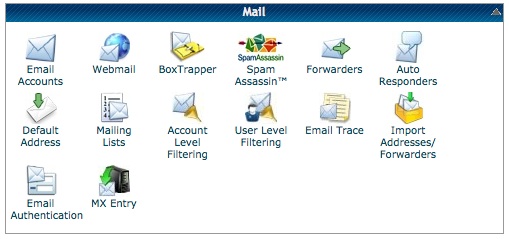How Business E-mail Works
E-mail addresses that end with @yourwebsite.com are most often configured at your web host unless you’ve specifically routed e-mail hosting elsewhere. It’s standard for e-mail hosting to be included with web hosting, but does not have to be. The most popular web hosts, GoDaddy, bluehost, Hostgator, etc, all include e-mail hosting with their website hosting packages.
No e-mail accounts exist until you create them for a website, and baring your e-mail being routed somewhere other than your web host, [something you would know] you create accounts at your web hosts website, inside of their control panel.
Once you setup an account, you’re provided with instructions to access webmail or use an e-mail program to send and receive e-mail.
NOTE: Services like Yahoo or Hotmail aren’t considered business e-mail providers, although several people use their free services for their business e-mail. These providers don’t let you add professional e-mail addresses [addresses with @yourwebsite.com] and many can, under their terms of service, terminate e-mail accounts for any reason at anytime.
Routing
You can change the default settings within your web host or domain registrar to route your e-mail hosting to other companies. This is typically done for advanced features, better webmail or spam blocking, or in the rare case that your web host does not provide e-mail hosting.
You may have heard of Google Apps before, one of the largest pieces of Google Apps is it’s e-mail hosting, which allows you to set up business e-mail accounts, but keep the familiar Gmail interface and useful features.
It’s possible [and common] to have:
- Your website registered at GoDaddy
- Your website hosted at Hostgator
- Your e-mail routing through Google Apps
Recommendations
Your needs typically dictate what e-mail setup is best, but having a professional e-mail account, one that ends in @yourwebsite.com, is a strong indicator you’re a legitimate business. I recommend setting this up, or having someone set it up at your web host.
The two most common scenarios are:
- Setup a forwarding only address that forwards e-mail to a personal e-mail address, [you can’t reply back from the business address using a forwarding only address]
- Setup a full fledged account, and check e-mail using webmail or use settings provided by the host to add the account to your e-mail program
If you use Gmail personally and want the ability to use to send and receive from all your e-mail accounts, check out the Gmail Unifier by clicking here.
IT Arsenal has a service specifically for e-mail setup. We see many entrepreneurs with @yahoo.com and @gmail.com addresses, so if you’re interested in having a professional e-mail account added to your website, click here to order service.

